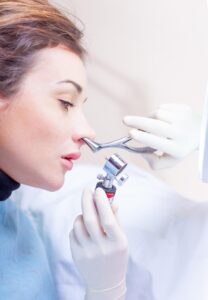Nasal Congestion
The common name for nasal congestion is a stuffy nose. Nasal congestion can be a symptom of a health problem like sinusitis or a cold.
How does congestion occur?
When a virus (such as a cold or flu), bacteria, or allergen affects the lining of the nasal passages, it causes inflammation of the blood vessels in the lining of the nasal passages and the nasal tissues. The tissues swell and nasal secretions (mucus) increase resulting in congestion. Congestion builds and can impair air flow. When mucus backs up in the nasal passages it can engorge the sinuses causing sinusitis.
What are the common causes of nasal congestion?
Nasal congestion is a primary symptom in:
- Allergic rhinitis or hay fever which affects up to 15% of adults. 80% of cases begin
before age 20. - The common cold, which is a viral infection of the nose and sinuses. This can be complicated by a secondary bacterial infection.
- Structural problems like a deviated septum in the nose that also impairs air flow.
- Sinusitis, which may be viral or material, and may be with or without associated nasal
polyps.
Some of these conditions are self-limiting. For instance, congestion from a cold usually goes away by itself within 7-10 days. Allergic rhinitis lasts as long as the irritants (such as pollens, dust mites, etc.) are present, usually at least four months.
Colds generally last 7-10 days.
Symptoms of a cold:
- nasal congestion
- sore throat
- sneezing
- loss of smell
- coughing
- runny nose
- fatigue
- body aches
Sinus infections can last anywhere from a week to over a month.
Congestion caused by a sinus infection:
- nasal congestion
- sinus pain and pressure in the cheeks, forehead and around the eyes
- thick discolored mucus
- fever
- headache
- bad breath
- dental pain
What can you do when you suffer with congestion?
To help mucus thin and drain use a vaporizer to inhale warm, humidified air. You can also use a saline nasal spray or a nasal wash to remove thick mucus as well as nasal irritants. Congestion usually gets worse when you lie down so elevate the head and back while sleeping can help. Use over-the-counter decongestants, antihistamines. If you use an over the counter nasal spray, read the directions carefully because some sprays can be habit-forming if used for longer than a few days.
When should you call Fayetteville Otolaryngology?
- When you have a sore throat or spots on your tonsils
- When the mucus smells rotten, or the discharge is white or yellow
- When you have a cough that lasts longer than ten days
- When you cough up yellow, green or gray mucus
- When symptoms last more than three weeks
- When you have nasal secretions and a fever
What are the treatment options for nasal congestion?
Septoplasty (Correction of deviated nasal septum)
In between each nostril, there is an internal wall made up of cartilage and bone. When this internal wall becomes crooked and blocks the nasal passages it is called a deviated nasal septum. A septoplasty is a surgical procedure to correct this deviation and return the nasal passage to normal. This is either performed at an ambulatory surgical facility or the physician’s office.
VivAer Office Procedure
A “stuffy nose” or nasal congestion can happen for a variety of reasons. One common reason is a narrow nasal valve. The nasal valve is the opening located just inside each nostril. For many people, this can be the narrowest point in their nasal airway, creating a bottleneck for airflow.
VivAer is an in-office procedure that uses a radiofrequency wand to strengthen and thin out the tissue on either side of the nasal valve to create a larger entrance to the nasal airway. This procedure does not require any incisions, does not cause any visible change to the outside of the nose, and requires minimal downtime for recovery.
RhinAer Office Procedure
Is your nose always runny? Are you bothered by chronic postnasal drip? Are you tired of having to use nasal sprays all the time? If this sounds familiar, you may have chronic rhinitis. Rhinitis can be persistent even after appropriate allergy and sinus treatment, and it could be due to overactivity of the posterior nasal nerves. This bundle of nerves is located in the back of the nose and controls the amount of mucous your nose produces.
RhinAer is a procedure that uses a radiofrequency wand to decrease posterior nasal nerve activity, giving you relief from chronic runny nose and postnasal drip. This procedure is done under local anesthesia in the office and requires minimal downtime for recovery.
Allergy Testing and Diagnosis
Fayetteville Otolaryngology has been helping sufferers of environmental allergies since 1993. We offer testing and treatment to include indoor, outdoor, seasonal, and year-round allergens.
If our physicians suspect that your symptoms are due to allergies, you can be tested for allergies right in the office. Our testing methods are quick and efficient at identifying specific allergens. Skin testing takes between 1.5 to 2 hours and you will find out your results at the conclusion of the testing session.
To learn more please click Allergy Testing and Diagnosis



 / 103 Reviews
/ 103 Reviews